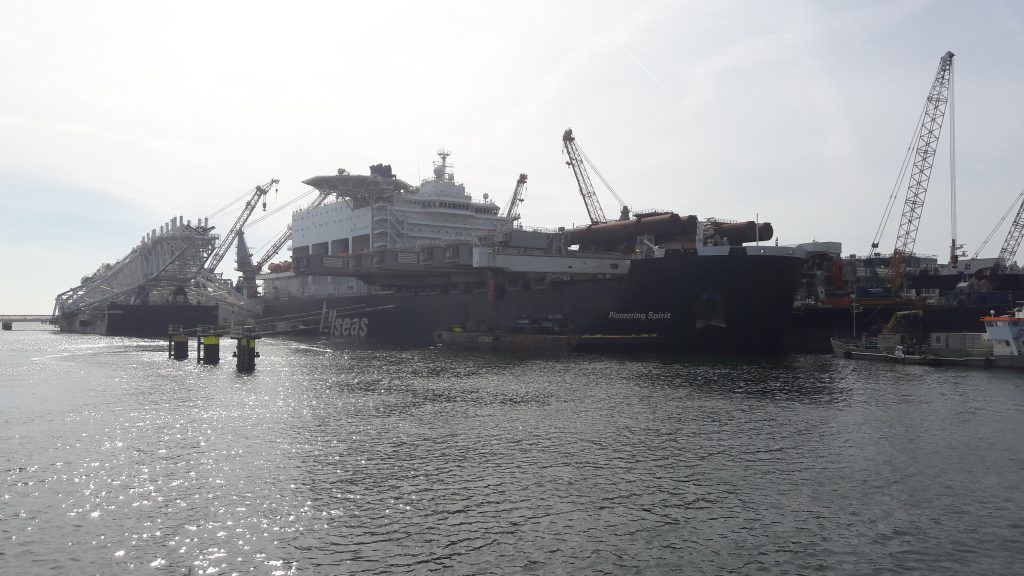
At nearly 400 metres long and more than 100 metres wide, the Pioneering Spirit dwarfs the Titanic.
It also overshadows the Nimitz class aircraft carrier.
And in fact any other ship in the world – if measured by displacement.
But whatever you do, “do not call it a boat”.
Those were the words of warning from Shell’s Brent decommissioning manager, Duncan Manning, as he prepared to show off the vessel that will undertake one of the biggest North Sea challenges to date.
He said: “You can put a boat on a ship but you can’t put a ship on a boat. That’s how I remember it.”
However the task at hand is slightly more complex than simply placing one vessel atop another.
Shell wants to take the 24,000 tonne “top” off its Brent Delta platform and ship it back to the UK mainland for decommissioning at Able’s Teesside yard.
Manning, a former Royal Marine who carried out security operations at the London 2012 Olympics, treats the project with the requisite military precision.
And getting the right tools is essential for the job.
When the project went out to tender there was no ambition to break records, claimed Manning’s colleague, Alistair Hope.
It just so happened that the best offer came from Swiss-based offshore contractor Allseas – and the behemoth Pioneering Spirit.
Hope said that the age and complexity of the facility made it an ideal candidate to put the Pioneering Spirit’s strength to the test.
He added: “The Brent Delta’s been modified a lot over the years. It’s a very complicated beast to dismantle.
“Any work you do offshore is intrinsically expensive. Bringing it onshore and dismantling it in a more controlled environment should be cheaper and safer.”
The ship has already proved itself lifting the 13,500 tonne Yme platform from the Norwegian sector of the North Sea.
A 30 year pipe dream of Allseas president Edward Heerema, the heavy lift vessel looks like two giant oil tankers have been joined together in bizarre experiment to make a colossal catamaran.
The concept behind the project is simple.
The twin-hulled design sails up and positions an oil rig in the gaping maw between the two fore decks.
A series of gas compressed hydraulics are capable of lifting more, reportedly nearly 50,000 tonnes.
These struts ‘jack up’ the top half of a platform from its legs.
The Pioneering Spirit then reverses thrust and takes the topside with it – leaving one handy chunk to deposit on land.
According to Shell, this minimises risks associated with offshore work and also removes the need for a barge to be on commission for months on end, taking it apart module by module.
And with a complex dynamic positioning (DP) system and 12 thrusters placed around the hull, the margins for error have been reduced to centimetres.
Proudly standing on the bridge of the vessel, Heerema said the ship has the stability to pull off the feat, scheduled for next month.
He said: “This has been 30 years in development.
“It’s been a very long wait to get here, to solve all the technical challenges.
“But it was worth it.”
He added: “Now we are nearly ready to do a very big lift like the Brent Delta.
“When in the northern North Sea, the vessel will always be rolling, swaying and titling.
“When you install or remove a topside you have to take all those elements out of the equation before you can do the lifting action.
“So you have to wait many weeks for the weather or you have to have a motion composition system.
“This vessel is very sophisticated. It takes out all the motion in three dimensions.”
Watching over the lift will be captain Fred Regtop, of Allseas.
He added: “This is a dream come true, to be captain of the biggest ship in the world.
“It is the ultimate piece of machinery. You can’t find a ship with more equipment than this one.”
Once the topside is removed, which can be done within a day if all goes well, claims Allseas, it will be shipped to Teesside.
Decommissioning firm Able has spent the best part of £30million in recent years, strengthening a new quay to make it capable of holding such heavy loads.
Able founder and chairman Peter Stephenson said: “We are investing for the future.
“It’s getting our foot in the door early so we can do projects like this.
“We’ve been pushing this idea for 30 years. It saves helicopter flights, saves bringing waste to shore, it avoids weather delays – there’s a lot more benefits to the client.
“It’s something to really get our teeth into.”
The Delta’s older sister, the Brent Bravo will be next to get a lift to shore in one piece.
Meanwhile the Brent Alpha’s wells are currently being plugged, with a lift scheduled for the next few years.
Just remember if you see it, it’s a ship – not a boat.
Recommended for you
